
-
 Afrikaans
Afrikaans -
 Albanian
Albanian -
 Amharic
Amharic -
 Arabic
Arabic -
 Armenian
Armenian -
 Azerbaijani
Azerbaijani -
 Basque
Basque -
 Belarusian
Belarusian -
 Bengali
Bengali -
 Bosnian
Bosnian -
 Bulgarian
Bulgarian -
 Catalan
Catalan -
 Cebuano
Cebuano -
 China
China -
 China (Taiwan)
China (Taiwan) -
 Corsican
Corsican -
 Croatian
Croatian -
 Czech
Czech -
 Danish
Danish -
 Dutch
Dutch -
 English
English -
 Esperanto
Esperanto -
 Estonian
Estonian -
 Finnish
Finnish -
 French
French -
 Frisian
Frisian -
 Galician
Galician -
 Georgian
Georgian -
 German
German -
 Greek
Greek -
 Gujarati
Gujarati -
 Haitian Creole
Haitian Creole -
 hausa
hausa -
 hawaiian
hawaiian -
 Hebrew
Hebrew -
 Hindi
Hindi -
 Miao
Miao -
 Hungarian
Hungarian -
 Icelandic
Icelandic -
 igbo
igbo -
 Indonesian
Indonesian -
 irish
irish -
 Italian
Italian -
 Japanese
Japanese -
 Javanese
Javanese -
 Kannada
Kannada -
 kazakh
kazakh -
 Khmer
Khmer -
 Rwandese
Rwandese -
 Korean
Korean -
 Kurdish
Kurdish -
 Kyrgyz
Kyrgyz -
 Lao
Lao -
 Latin
Latin -
 Latvian
Latvian -
 Lithuanian
Lithuanian -
 Luxembourgish
Luxembourgish -
 Macedonian
Macedonian -
 Malgashi
Malgashi -
 Malay
Malay -
 Malayalam
Malayalam -
 Maltese
Maltese -
 Maori
Maori -
 Marathi
Marathi -
 Mongolian
Mongolian -
 Myanmar
Myanmar -
 Nepali
Nepali -
 Norwegian
Norwegian -
 Norwegian
Norwegian -
 Occitan
Occitan -
 Pashto
Pashto -
 Persian
Persian -
 Polish
Polish -
 Portuguese
Portuguese -
 Punjabi
Punjabi -
 Romanian
Romanian -
 Russian
Russian -
 Samoan
Samoan -
 Scottish Gaelic
Scottish Gaelic -
 Serbian
Serbian -
 Sesotho
Sesotho -
 Shona
Shona -
 Sindhi
Sindhi -
 Sinhala
Sinhala -
 Slovak
Slovak -
 Slovenian
Slovenian -
 Somali
Somali -
 Spanish
Spanish -
 Sundanese
Sundanese -
 Swahili
Swahili -
 Swedish
Swedish -
 Tagalog
Tagalog -
 Tajik
Tajik -
 Tamil
Tamil -
 Tatar
Tatar -
 Telugu
Telugu -
 Thai
Thai -
 Turkish
Turkish -
 Turkmen
Turkmen -
 Ukrainian
Ukrainian -
 Urdu
Urdu -
 Uighur
Uighur -
 Uzbek
Uzbek -
 Vietnamese
Vietnamese -
 Welsh
Welsh -
 Bantu
Bantu -
 Yiddish
Yiddish -
 Yoruba
Yoruba -
 Zulu
Zulu
grp products for steel smelting plant
Innovative GRP Products for Steel Smelting Plants
The steel industry plays a pivotal role in modern infrastructure development, necessitating advanced technologies and materials for efficient production. An essential component of this industry is the steel smelting plant, which transforms raw materials into steel through high-temperature processes. As environmental regulations tighten and demands for sustainability rise, the development and adoption of Glass Reinforced Plastic (GRP) products have emerged as a transformative solution for steel smelting plants.
GRP, also known as fiberglass, is a composite material made from a polymer matrix reinforced with glass fibers. This material offers distinct advantages over traditional materials like steel and concrete in various applications, making it an ideal choice for steel smelting plants. One of the most significant benefits of GRP is its remarkable resistance to extreme temperatures and corrosive environments. In steel smelting plants, where intense heat and chemical exposure are common, GRP components can withstand the rigorous conditions without degrading, thus enhancing operational longevity and reducing maintenance costs.
Innovative GRP Products for Steel Smelting Plants
The versatility of GRP allows for the creation of a wide range of products tailored to the specific needs of steel smelting plants. From storage tanks, piping systems, and ductwork to protective equipment and structural components, GRP can be molded into various shapes and sizes, accommodating unique designs and operational requirements. For instance, GRP duct systems are increasingly favored for transporting exhaust gases due to their corrosion resistance and low thermal conductivity, ensuring efficient operation while mitigating environmental impact.
grp products for steel smelting plant

In addition to its technical advantages, GRP products also contribute to sustainability efforts within the steel industry. The manufacturing process of GRP can be more environmentally friendly compared to traditional materials, producing fewer carbon emissions. Moreover, the lightweight nature of GRP reduces energy consumption during transportation and installation, further minimizing the overall carbon footprint of steel smelting plants.
Moreover, the adaptability of GRP allows for innovative solutions that can integrate advanced technologies within steel smelting operations. For example, GRP can be used in conjunction with sensors and monitoring systems to create intelligent infrastructure capable of real-time performance assessment. This advancement supports proactive maintenance strategies, ensuring that potential issues are identified and resolved before they escalate into significant problems, thereby improving safety and efficiency.
As the steel industry continues to evolve, the adoption of GRP products in steel smelting plants presents an opportunity to harmonize productivity with environmental responsibility. The transition to these advanced materials not only enhances the operational performance of smelting facilities but also aligns with global efforts to reduce carbon emissions and promote sustainable industrial practices.
In conclusion, the integration of GRP products into steel smelting plants represents a significant advancement in material technology, offering a combination of durability, versatility, and sustainability. As the industry faces mounting challenges related to efficiency and environmental impact, GRP stands out as a solution that can help bridge the gap between traditional steel manufacturing methods and modern sustainable practices. By embracing innovation through GRP, steel smelting plants can pave the way for a more sustainable and efficient future in steel production.









